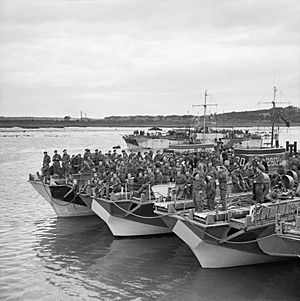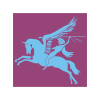List of British special service brigades of the Second World War facts for kids
In mid-1940, after the Allied forces faced defeat in the Battle of France, the British Army started creating special units. These units were meant to carry out quick "hit and run" attacks on areas in Europe controlled by Germany. This showed that the British Army could still fight offensively, even when most of its soldiers were busy defending the UK. These special forces were called "commandos."
By the end of 1940, the commando force had grown quite large. It was reorganized to better manage its structure. As the war continued, more commando units were formed. Their role changed from just raiding to also leading major attacks and fighting as light infantry. This led to the creation of four commando brigades. These brigades were key to British Army attacks in Northwest Europe, Italy, and Burma. The growth also led to the formation of the Special Air Service (SAS). By 1944, the SAS also became a brigade-sized group, keeping its raiding role. SAS units usually worked deep behind enemy lines, often on their own. All five brigades stayed active until the war ended and were then disbanded.
Contents
Why were special forces needed?

In June 1940, after the Allies lost the Battle of France and British soldiers had to leave Dunkirk, British Prime Minister Winston Churchill asked for a new type of force. He wanted them to perform quick raids on German-controlled Europe. These raids would show that Britain could still fight back, even while its main army was defending the UK. This was also meant to boost public spirits.
This new volunteer force was named "commandos" by Lieutenant-Colonel Dudley Clarke. They carried out their first raid soon after they were formed. The idea was that these units could work on their own for about 24 hours to complete their missions.
How the Commandos were organized
In November 1940, as more commando units were created, there was a need for better control. So, the Special Service Brigade was formed. Five Special Service Battalions were created by combining smaller commando units. Each battalion had two companies, and each company had ten "troops" of 50 men.
By February 1941, this new setup wasn't working well. The units were too big to control easily during training. They were also too large to fit onto a small number of ships. For example, a 1,000-man commando battalion needed many Landing Craft Assault boats to get ashore. This made it hard for the units to work together as a single team.
So, the brigade was reorganized. The term "special service battalion" was dropped, and each unit was simply called a "commando." After this change, the brigade had six commandos, each with six troops of 65 men. This new size meant one commando unit could fit on one or two ships, making it easier to transport them for missions.
Commandos take on new roles
During 1941 and 1942, more commandos were formed. Some were British, and others were volunteers from European countries under German control. Some of these new units also joined the Special Service Brigade. By 1942, the commandos' job grew to include leading large amphibious attacks (attacks from the sea onto land). They were used in bigger numbers and fought in longer battles than originally planned.
By October 1943, the commandos were reorganized again to fit this new role. The Special Service Brigade was replaced by the Special Service Group. Then, four new Special Service Brigades were formed. Each had four commando units from the army and Royal Marines. While these brigades still did some small raids, they mostly served as assault troops or light infantry.
On December 6, 1944, the name "Special Service" was removed from the brigade titles and replaced with "Commando." The soldiers didn't like "Special Service" because its abbreviation, "SS," sounded like the German Schutzstaffel, or SS. After the war ended in 1946, most of these brigades and commando units were disbanded. Only the 3 Commando Brigade remained for peacetime service, continuing the commando tradition.
The Special Air Service (SAS) is born
In 1941, the Special Air Service (SAS) was created from commando forces in the Mediterranean and Middle East. It was first known as L Detachment. The SAS grew and carried out secret operations behind enemy lines against Axis forces in that region.
In January 1944, the Special Air Service Troops brigade was formed. It had about 2,000 men, including two British regiments, two French regiments, and a Belgian squadron. This brigade was based in the UK, so the British soldiers had to return home from the Mediterranean. The brigade adopted the maroon beret worn by British airborne forces. The British troops had to give up their beige berets. The French and Belgian soldiers also wore the British airborne Pegasus shoulder badge.
This brigade was not meant to fight as one big group like the Commando Brigades. Instead, individual SAS units were sent out separately. Their first job was to support the Allied invasion of German-occupied France. They landed deep inside France to set up bases, attack German positions, and work with the French Resistance. While some SAS units were in France, others were dropped into Italy to help the Italian resistance movement. In October 1945, the Special Air Service Troops brigade and its units were disbanded.
Special Service Brigades in World War II
| Brigade Name | Formed | Disbanded | Where they served | Key missions | Important facts | Source(s) |
|---|---|---|---|---|---|---|
| Special Service Brigade | 1 November 1940 | November 1943 | UK, Norway, France | Raids on the Atlantic Wall | Formed to command various special service battalions. In 1941, these battalions were renamed "commandos." In November 1943, it was replaced by a new headquarters that controlled four new brigades. | |
| 1st Special Service Brigade | November 1943 | N/A | Italy, UK, France, Belgium, Netherlands, Germany | Allied invasion of Sicily, Normandy, Allied advance from Paris to the Rhine, Western Allied invasion of Germany | Renamed 1 Commando Brigade on December 6, 1944. | |
| 2nd Special Service Brigade | November 1943 | N/A | Italy, Yugoslavia, Albania | Italy, Adriatic | Renamed 2 Commando Brigade on December 6, 1944. | |
| 3rd Special Service Brigade | November 1943 | N/A | Italy, British India, Burma | Allied invasion of Sicily, Burma | Renamed 3 Commando Brigade on December 6, 1944. After the war, it helped re-establish British rule in Hong Kong. | |
| 4th Special Service Brigade | November 1943 | N/A | UK, France, Belgium, Netherlands, Germany | Normandy, Allied advance from Paris to the Rhine, Scheldt | Renamed 4 Commando Brigade on December 6, 1944. After fighting, it helped with occupation duties in Germany. | |
| Special Air Service Troops | 7 January 1944 | N/A | UK, France, Italy, Belgium, Netherlands, Germany, Norway | France, Italy, Western Allied invasion of Germany | This brigade did not fight as one unit. Instead, it managed various SAS units operating across Europe. Its headquarters stayed in the UK for most of the war. |
See also
- British Army during the Second World War
- List of British deception formations in World War II, for the 104th Special Service (Commando) Brigade
- British Commando operations during the Second World War
- Chindits, also known as Special Force
Images for kids




